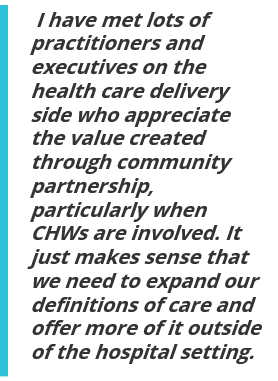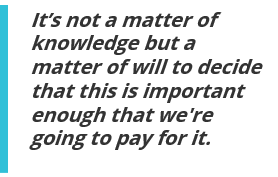By Emma Opthof, Center for Health Care Strategies
An awkward teenager with lots of promise and energy. This is essentially how Robert Fields, MD, MHA, senior vice president and chief medical officer of Population Health at Mount Sinai Health System, and Shoshanah Brown, MS, MBA, founder and CEO of AIRnyc — a community-based organization (CBO) that supports community health workers (CHWs) in addressing health-related social needs — describe their evolving partnership. Relationships between health systems and CBOs can be fraught with issues like inconsistent funding, community mistrust of health systems, and data-sharing challenges. But with increasing awareness about the impact of social factors on health, more and more health systems are reaching out to CBOs for their community expertise and experience in supporting patients with complex needs.
While several clinicians from Mount Sinai and AIRnyc began collaborating years before the Delivery System Reform Incentive Payment (DSRIP) program, it was the New York State Medicaid Redesign initiative that helped to formalize the partnership, set up workflows for care coordination, and provide funding. When COVID-19 hit New York City in March, Mount Sinai wanted to reach out to tens of thousands of high-risk patients with increased social needs, and so turned to AIRnyc to augment their community engagement capacity. They built their infrastructure and strategy around the Pathways Hub model that leverages CHWs, which addresses several social domains and has produced strong outcomes. The Better Care Playbook recently spoke with both leaders to learn about their partnership and what other health systems and CBOs should consider to improve their relationships to make meaningful changes in their communities, following up on a recent Playbook webinar.
Q: What are the key opportunities and challenges in developing this partnership?
A: R. Fields: If we can partner with the community to reach two, three, or four times the number of people, we've increased the probability that we're going to have enough positive impact on the upstream drivers of health to see that reflected in the clinical and financial outcomes of the population. There's an opportunity to partner with CBOs as a resource to do the things that they've always done — improve the health of communities. Another opportunity is financial alignment to pressure health systems to partner with CBOs in risk contracts. There have always been people who are trying to strive to improve the health of communities, but the health systems were slow to recognize it because they functioned purely in a fee-for-service environment. That’s changing, which is good.
In terms of the barriers, hospital staff still get really tense about sharing data with CBOs in the same way we would with medical agencies. Going back to the financial structures, how does a payer pay for CBO services and the CHW services without sharing data? While we might understand the benefits of partnering with a CHW CBO philosophically, we still have some barriers operationally.
S. Brown: Our greatest value as an independent CBO comes from being community rooted. Our work is most impactful when we can remain in the community and connect to the clinicians, the payers, and the health care delivery system. When we have strong relationships with clinicians at the individual level, backed by protocols for collaboration within the health system, our program works best. We become part of a care team that extends beyond the clinical setting and enables effective coordination, allowing us to understand more about patient needs and priorities. The clinicians we work with can provide that warm handoff to our community group, which builds trust across the whole continuum.
Data sharing, technology, financing are all serious hurdles, but I'm an optimist. I think things are getting better. People are increasingly recognizing the critical role that CHWs can play in building bridges between medical and social care. As CHWs, people talk to us differently, they share more about the realities of their lives outside of a clinical setting. We work to make sure that we aren't judging people. We aren't evaluating who they are or their choices. We're showing up to try to support and motivate them, to be their advocates in overcoming whatever barriers to health are in their way.
For example, for patients with chronic conditions where medication is involved, we can spend the extra time to help them better understand, manage, procure, and adhere to their medications. When clinicians have visibility into the ways we can support people in adhering to treatment plans, those clinicians tend to be our biggest champions. However, the lack of interoperability between our data platforms and the hospital-based systems makes it challenging for clinicians to share patient-level data with us. It is unrealistic to think that synchronous communication is always possible in coordinating care, but when we do find ways to share pertinent data back and forth, our interventions work beautifully.
I have met lots of practitioners and executives on the health care delivery side who appreciate the value created through community partnership, particularly when CHWs are involved. It just makes sense that we need to expand our definitions of care and offer more of it outside of the hospital setting, and that was true before the pandemic! If we can figure out how to scale these programs and stop doing pilot after pilot, going in circles about whether we can achieve return on investment (ROI) or whether these programs are worth the money, we could be improving health and quality of life for many more people.
Q: What are important data-sharing considerations to support this type of partnership and enable meaningful data collection to track program impact?
A: S. Brown: We need to make it easy for clinicians to refer patients to CBOs without compromising data security standards. CBOs have to build data management capacity to receive and send data while maintaining appropriate privacy controls. We need to enable clinicians to receive germane patient-level data — preferably at the point of care — from CBOs so they can integrate what we've learned outside of the medical walls. We then to need to make sure that the analytics or the data we share comes back to CBOs so that we learn together what is working and what we need to change in order to achieve our desired goals.
Second, we need more harmonization and standardization of how we define, collect, and analyze data on the social determinants of health (SDOH). We've come a long way in terms of screening, but now we're screening everybody multiple times asking the same sensitive questions: Are you hungry? Do you have enough money to pay for the medication I just prescribed? Do you have heat? Are you afraid of losing your home? It is burdensome to keep asking these questions for the sake of data collection and then not have the value of that data collection accrue to the human in front of you. We should only be collecting data if it's going to change our management. Not only are we overwhelming patients, but the data collection requirements can undermine the whole purpose of the engagement – to connect with people and build trust.
Finally, we need to coordinate our decision-making for social care navigation. There are many competing tech vendors including Aunt Bertha, Unite Us, NowPow, Healthify, and others who are all trying to address this problem of fragmentation in human services and social care, but as payers and systems select different vendors and require downstream partners to operate on these different systems that don't interface, it creates serious challenges for everyone.
R. Fields: We’re in danger of replicating the mistakes we made with electronic medical records 30 years ago in terms of fragmenting the data, having the vendors own the data, and overburdening clinicians in data entry and management. And we're about to do the same thing again with CHWs, so I hope that we learn from those mistakes.
The only other thing that I would add is that there are regional differences in how we use data. New York is one of the few opt-in states for the health information exchange left in the country and it's under the auspices of consumer protection. I'm all about protecting data for the consumer, but there are unintended consequences of those decisions that make it difficult to provide better care.
Q: What is the future of involving CBOs in value-based payment contracts and what capacities are needed to get there?
A: S. Brown: We’ve certainly learned a lot through the efforts around Medicaid redesign in New York. Thinking about ways to become part of independent physician associations and accountable care organizations where CHWs can be like any provider and participate in value-based contracting is important. We still need more work on incentive alignment so that CBOs have mechanisms to add value in the form of shared savings.
R. Fields: I'm often reminded of The Commonwealth Fund brief of health care spending among peer countries. We've all seen the one where the U.S. outspends everybody, but if you combine social spending and health care spending, we're almost right in the middle. The difference between us and our peer countries is that we spend two thirds on health care and one third on social care where everyone else is flipped. We could decide that as a country, we're going to affect policies so we spend two thirds on social care and one third on health care. That doesn't feel politically likely to happen anytime soon. The other option is, can we use health care spending to fund social care? Some states like North Carolina have made progress on at least establishing something that looks like a system of payment for social care tapping into medical dollars.
It’s not a matter of knowledge but a matter of will to decide that this is important enough that we're going to pay for it. We pay all sorts of exorbitant prices for things that are low value. Chief financial officers often ask about ROI when it comes to investments in SDOH interventions. We could come up with a payment model for food or housing or things like that without having to determine ROI — we don't ask that of any other health care providers in the same way.
Q: What advice would you give to other organizations — both health systems and CBOs — interested in developing partnerships around community-based care strategies?
A: S. Brown: We need accountability on all sides. We need to build things together in true partnership. I think CBOs have to be willing to appreciate the value of integrating with clinical systems, which can sometimes be at odds with their missions.
R. Fields: The only thing I would emphasize is it doesn't have to be perfect — if there is will to do it, just start on something. Almost always, like everything else, it involves relationships, but often health systems don't have great relationships with nonprofit partners or communities because of the history of how health systems have negatively impacted communities, often based on projects or grants that go away. The biggest thing if you’re a health system stakeholder is to acknowledge your imperfections and establish some trusting relationships with community stakeholders. Start something small — even if it's 10 people — and commit to actually doing the job. Hopefully, that can be a starting point to build on.




